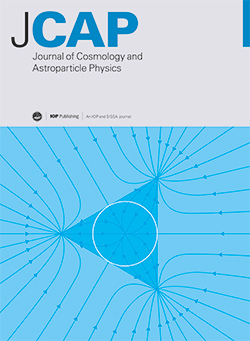Kinetic field theory: effects of modified gravity theories with screening mechanisms on non-linear cosmic density fluctuations
IF 5.3
2区 物理与天体物理
Q1 ASTRONOMY & ASTROPHYSICS
Journal of Cosmology and Astroparticle Physics
Pub Date : 2025-03-06
DOI:10.1088/1475-7516/2025/03/008
引用次数: 0
Abstract
In a mean-field approximation within Kinetic Field Theory, it is possible to derive an accurate analytic expression for the power spectrum of present-day non-linear cosmic density fluctuations. It depends on the theory of gravity and the cosmological model via the expansion function of the background space-time, the growth factor derived from it, and the gravitational coupling strength, which may deviate from Newton's constant in a manner depending on time and spatial scale. In earlier work [1], we introduced a functional Taylor expansion around general relativity and the cosmological standard model to derive the effects of a wide class of modified-gravity theories on the non-linear power spectrum, assuming that such effects need to be small given the general success of the standard model. Here, we extend this class towards theories with small-scale screening, modeling screening effects by a suitably flexible interpolating function. We compare the Taylor expansion with full mean-field solutions and find good agreement where expected. We find typical relative enhancements of the non-linear power spectrum between a few and a few ten per cent in a broad range of wave numbers between k ≳ 0.1-10 h Mpc, in good qualitative agreement with results of numerical simulations. Taking nDGP gravity as a quantitative example we compare our results to N-body simulations and find percent-level agreement for wavenumbers k ≲ 2 h Mpc-1, if the scale where screening sets in, k*, is adapted appropriately. This extends the application of our analytic approach to non-linear cosmic structure formation to essentially all classes of modified-gravity theories.求助全文
约1分钟内获得全文
求助全文
来源期刊

Journal of Cosmology and Astroparticle Physics
地学天文-天文与天体物理
CiteScore
10.20
自引率
23.40%
发文量
632
审稿时长
1 months
期刊介绍:
Journal of Cosmology and Astroparticle Physics (JCAP) encompasses theoretical, observational and experimental areas as well as computation and simulation. The journal covers the latest developments in the theory of all fundamental interactions and their cosmological implications (e.g. M-theory and cosmology, brane cosmology). JCAP''s coverage also includes topics such as formation, dynamics and clustering of galaxies, pre-galactic star formation, x-ray astronomy, radio astronomy, gravitational lensing, active galactic nuclei, intergalactic and interstellar matter.
 求助内容:
求助内容: 应助结果提醒方式:
应助结果提醒方式:


